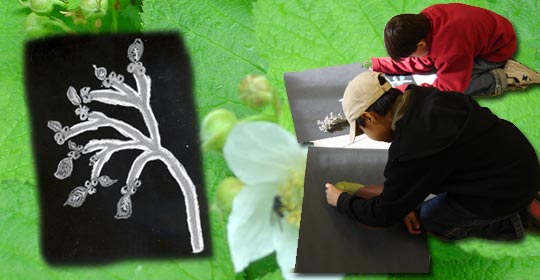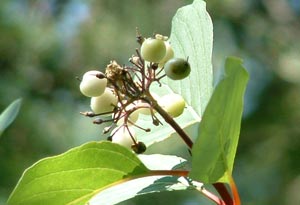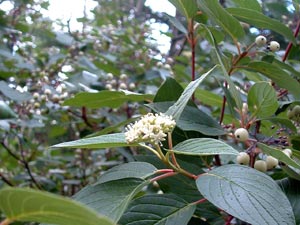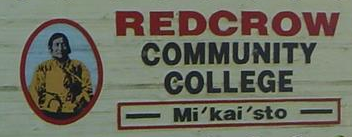Mi’kotsíípiiyis – Cornus stolonifera (Red Bush)

Noah is drawing Red-osier Dogwood in pastels.
Red-osier Dogwood

Cornus stolonifera
Galileo Educational Network
*WARNING: All parts of Red-osier Dogwood can be poisonous, if taken in large amounts.
Red-osier Dogwood is a bush with red bark that grows in coulees and damp ravines to a height of 90-180 cm. The stems are quite bendable and its medium green leaves are rounded at the base with a pointed tip and with short hairs at the bottom. In June, this Dogwood blossoms with tiny (1 mm) greenish white flowers that are clustered together in groups of 8-12 that make them look much bigger. When the flowers change to fruit later in the summer, the Dogwood has round, creamy white, waxy berries that have two seeds. The plant is also sometimes called red willow or red-osier willow, but it is not a willow!
Red-osier Dogwood berries, along with Saskatoon berries, were a favorite snack reserved for men among our elders. Leaves from the Dogwood are mixed with kinnikinnick, dried cambium and tobacco and used in all religious bundles. The outer bark is scraped away and the inner greenish bark scraped off and smoked with tobacco. It has a distinctive and pleasant smell, but it can have a “narcotic” effect, like drugs.
The inner bark can be made into a medicine tea to treat liver problems and chest troubles.
Cornouiller stolonifère

Cornus stolonifera
Galileo Educational Network
*AVERTISSEMENT : Toutes les parties du cornouiller stolonifère peuvent être toxiques si elles sont consommées en grandes quantités.
Le cornouiller stolonifère est un arbuste à l’écorce rouge qui pousse dans les coulées et les ravins humides. Il atteint une hauteur de 90 à 180 centimètres. Ses tiges sont très souples. Ses feuilles, d’un vert moyen, sont rondes à la base et pointues à l’extrémité. Le dessous des feuilles est velu. En juin, le cornouiller stolonifère laisse apparaître de petites fleurs (1 millimètre) d’un blanc qui tire sur le vert. Elles poussent en grappes de 8 à 12 fleurs, ce qui les fait paraître beaucoup plus grosses. Quand les fleurs se transforment en fruits à l’été, le cornouiller produit des petits fruits cireux de couleur blanc crème à deux graines. Certaines personnes appellent parfois cette plante “saule rouge” ou “saule stolonifère”, mais ce n’est pas un saule!
Les fruits du cornouiller stolonifère, tout comme les fruits de l’amélanchier, étaient un des goûters préférés de nos aînés de sexe masculin, et ils leurs étaient réservés. Aussi, il est possible de mélanger les feuilles du cornouiller avec du kinnikinnick, du cambium séché et du tabac afin de nous en servir dans tous nos ballots sacrés. Nous enlevons le dessus de l’écorce et prenons l’intérieur vert de l’écorce pour le fumer avec du tabac. L’odeur de ce mélange est agréable et distincte. Cependant, ce mélange peut avoir un effet “narcotique”, comme les drogues.
Avec l’intérieur de l’écorce, nous pouvons faire du thé pour traiter les troubles du foie et de la poitrine.

Cornus stolonifera
Galileo Educational Network
- Hellson, John C. (1974). Ethnobotany of the Blackfoot Indians. Ottawa: National Museums of Canada
- Kerik, Joan. (1979). Living With The Land: Use of Plants by the Native People Of Alberta. Edmonton, Alberta: Provincial Museum of Alberta.
- Moerman, Daniel E. (1998). Native American Ethnobotany. Portland: Timber Press.
- Tilford, Gregory. (1997). Edible and Medicinal Plants Of The West. Missoula, Montana: Mountain Press Publishing Company.
- Vance, F.R., Jowsley, J.R. & Mclean, J.S. (1984). Wildflowers Across The Prairies. Saskatoon, Saskatchewan: Western Producer Prairie Books.
- Willard, Terry. (1992). Edible and Medicinal Plants of the Rocky Mountains and Neighboring Territories. Calgary, Alberta: Wildrose College of Natural Healing.





